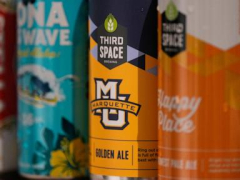MILWAUKEE — Missy Vraney and Kristin Westphal didn’t go to Marquette. Neither did any of their relatives. Yet their family tradition of attending Golden Eagles basketball games spans generations.
“Whenever our uncle couldn’t go, our dad would take one of us and just kind of alternate,” Vraney recalls.
They’re still supporting the school regularly — just in beer money rather than tuition fees. It happens every time they buy a Marquette Golden Ale before heading to the Fiserv Forum stands.
This marks the first season since Marquette entered a partnership with Milwaukee-based Third Space Brewing to sell Marquette Golden Ale — the school’s officially licensed and co-branded craft beer — at Golden Eagles sporting events as well as in Third Space outlets and area groceries. As part of the deal, 15% of the revenues go back to Marquette.
“People are extremely excited about it,” said Andy Gehl, the co-founder and president of Third Space Brewing. “People love drinking beer with their favorite school, their favorite sports team’s logo on it. That’s No. 1. Also, they want to support businesses that support their university, and vice versa.”
This has become the latest fund-raising trend for college athletics.
Learfield, which manages sports sponsorships for over 160 universities and licensing agreements for nearly 800 colleges, says that 93 of its schools had licensing deals for alcoholic beverages for the first six months of the current fiscal year. That’s a 57.6% rise from fiscal year 2023, when 59 schools had deals for their own signature alcoholic beverage.
The number of Learfield schools with licensing deals specifically with craft beers has more than doubled in that time – from 16 in 2023 to 36 this year.
Cory Moss, Learfield’s president of brand management and marketing, acknowledges he would have been surprised by this kind of growth four or five years ago. Then he started noticing more interest from the schools themselves and from various local craft breweries wanting to establish partnerships.
“When schools got really behind it and the craft industry really started to take it seriously, that’s when it really started to grow,” Moss said. “And that growth hasn’t been surprising.”
It represents a major change in





